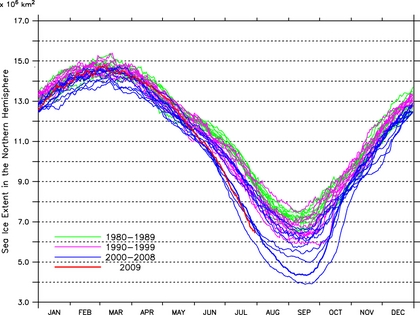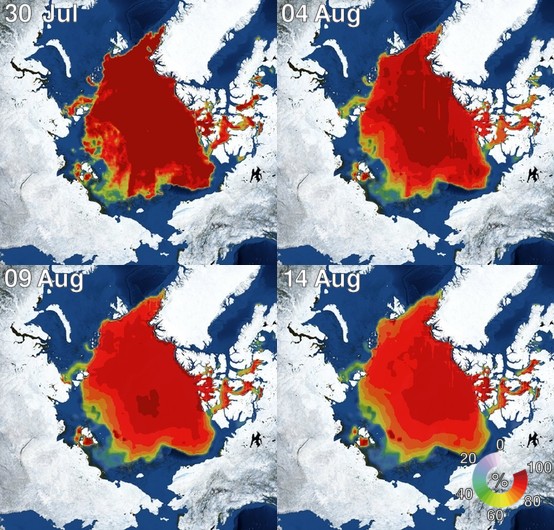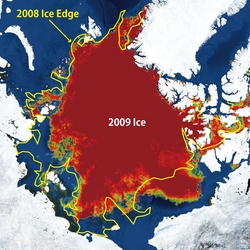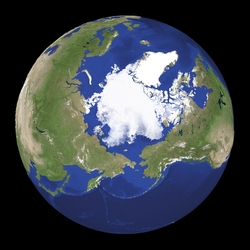2009.08.04
GIC Weekly Report for the Arctic Region Vol.1
We start operation, as 2009 suggests opening of NW/NE passages.
Topic of the Week
Overall sea ice coverage over the arctic region has shown similar change to that of 2008, in which both passages (North Western passage and North Eastern passage) opened for the first time in recorded history. One reason for this is that, sea ice extent was found to be at a record minimum in the summer of 2007, as a result of this, the presence of multi-year ice was severely reduced.
There is significant melting in the North Eastern passage this year, satellite images have suggested that sea ice around Taymyr peninsula is clearly reduced when compared to the summer of 2008. On the other hand, the Canadian arctic region within the North Western route is widely covered with fast ice and melting is slower than last year. This is because spring season temperatures were higher than last year within the North Western Passage and lower were lower for the North Eastern Passage.
If melting of sea ice in both Eastern and Western passages continues at this pace, both passages are expected to open simultaneously for second time in history. The North Eastern passage is of particular interest as it only opened for only a short time last year and may open earlier and longer in 2009. As 2009, marks an El Nino year, in which statistic analysis has shown that temperatures around the North Western passage have tended to be higher than average, as a result there is a chance that the North West passage may open. However the sea ice melting and the related passage's opening will be associated with Atmospheric and Oceanographic situations, therefore continuous monitoring is mandatory.
Weathernews Global Ice Center will keep monitoring and issue weekly report for Arctic region via our website.
Sea Ice Extent

|
Arctic Western Arctic Eastern Arctic |
Figure 2. Sea ice extent of the entire Arctic, western Arctic and eastern Arctic. (click to enlarge)
The long-term climatologically trend suggest that sea ice extent over the past decade has shown a significant reduction through out the summer months, when compared to previous decades, this can be seen in both the western and eastern passages. The western passage's sea ice extent annual trend indicates a significantly larger change in sea ice extent than the Eastern passage. The graphics indicate that this trend has increased over the past decade with both Western and Eastern passages decreasing to there lowest around September.
Sea Ice Conditions along Polar Routes
| NW Passage |
| Gulf of St.Lawrence |
Grand Banks |
Labrador Sea |
Davis Strait |
Baffin Bay |
Canadian Arctic E |
Canadian Arctic W |
Beaufort region |
Chukchi | Bering West |
| IF | IF | IF | IF | ||||||
| Greenland Sea SW |
Foxe Basin |
||||||||
| NE Passage |
| Bering West |
Chukchi | East Siberian |
Laptev | Kara Sea N |
Barents Sea NE |
Barents Sea S |
Barents Sea NW |
| IF | IF | IF | |||||
| Kara Sea S |
|||||||
| Ice Concentration | Passage situation | |
| equal or more than 7 |
ships can not sail without icebreaker | |
| 4-6 | ice-strengthend ships can sail | |
| less than 3 | ice-worthy ships can sail | |
| IF | Ice Free | normal ships can sail |
Table. Sea ice extent for each region in the Arctic, showing the labelled colors to indicate navigable routes around the North Eastern and North Western passages.
The North Western passage remains closed to vessels travelling through the arctic region. Within the Foxe Basin and the Canadian arctic west ice concentrations of 8-10/10th are dominant, making any route around these regions impossible. Sea ice within the Davis Strait has subsided providing a clear passage through this area, this is also the case for the Canadian Arctic East in which passage is possible through Lancaster Sound and the Barrow strait. The Beaufort and the Chukchi Sea are also ice free.
The North Eastern passage is also closed with sea ice concentrations of 8-10/10th in Laptev, Siberian and Kara Sea, However the Bering west and Chukchi sea are ice-free.
Model Prediction
Weathernews's I-SEE arctic ice model indicates a rapid decrease in sea ice pack concentration within the Arctic Ocean throughout the start of August and continuing through and to the middle of the month.
Temperatures are expected to remain above normal for all regions particularly throughout the eastern passage promoting a moderate rate of melting throughout the arctic region.

Figure 4. I-SEE engine, model predictions of Arctic sea ice.



